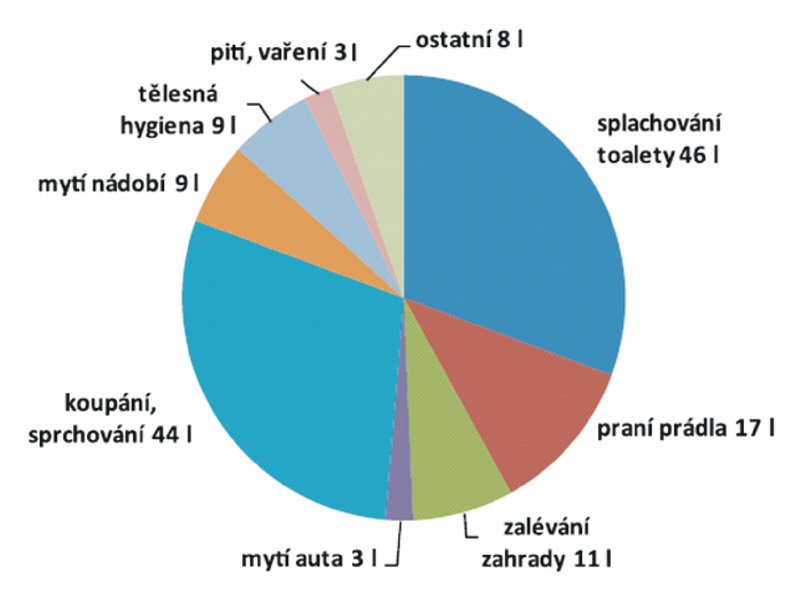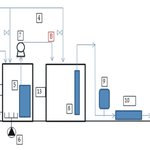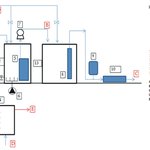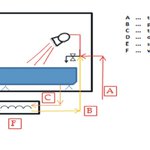1 GREYWATER RECOVERY
Greywater According
to EN 12056, greywater is wastewater coming from sinks, hand basins, bathtubs, showers, etc., but not containing human waste (urine and faeces). After its treatment, grey-water can be used as service water (i.e. white water) for flushing toilets, urinals and irriga-tion purposes.
Greywater classification:
- non-separated greywater,
- greywater from kitchen sinks and dishwashing,
- greywater from laundry machines,
- greywater from hand basins, bathtubs and showers, and
- other greywater types.
Fluctuations in the contamination level are typical for these sources; this is connected with different lifestyles of inhabitants. Wastewater least burdened with the contamination is pro-duced in showers and washing operations. According to their level of contamination, grey-water types can be divided to suitable and conditionally usable for recycling. The usable greywater comes from hand basins, bathtubs and showers, while the conditionally usable greywater comes from sinks and dishwashing.
In recent years, building certification systems as regards the influence to the environment are often applied in the practice. Buildings are certified according to one of the systems; systems as LEED (Leadership in Energy and Environmental Design) and BREAM (Building Research Establishment Assessment Method) are used in the first place. All these systems motivate the designers to use technical solutions reducing energy consumption and quantities of water discharged outside the buildings – the latter is known as the “water cycle management”. Reuse of greywater is one of possible ways how to reduce the drinking water consumption as well as the discharged volume of wastewater.
Description
Greywater treatment units are intended for the purification of wastewater containing hu-man waste, i.e. wastewater coming from showers, dishwashing and hand basins. This tech-nology utilises aerobic biological processes and it is provided with the membrane technol-ogy, which clears the purified water from a major part of viruses and bacteria. By its quality, the water purified in the way is comparable to rainwater and it can be used as the service water, for flushing toilets and irrigation purposes.
Technology description
Wastewater flows through the filter for mechanical particles (debris) into the balance reser-voir. This reservoir copes with flow irregularities - it accumulates the discharged water. From the balance reservoir, the wastewater is pumped into the reaction tank. In the reaction tank, the water is purified biologically. The reaction tank is provided with a membrane module. In its bottom part, there is an aeration system supplying the activation tank with oxygen and providing for cleaning of the membranes.
Above the membrane module, there is a pump that sucks the water off, under pressure, through the filtration membranes and drains the already purified water to the clean water accumulation tank. From the accumulation tank, the water is pumped by an automatic pres-sure unit to the service-waster distribution system. Beyond the pumping station, there is a membrane pressure vessel. As the last in the downstream, there is an ultraviolet (UV) lamp for the water disinfecting process. All tanks are provided with emergency overflows and equipment for feeding with drinking water under emergencies.
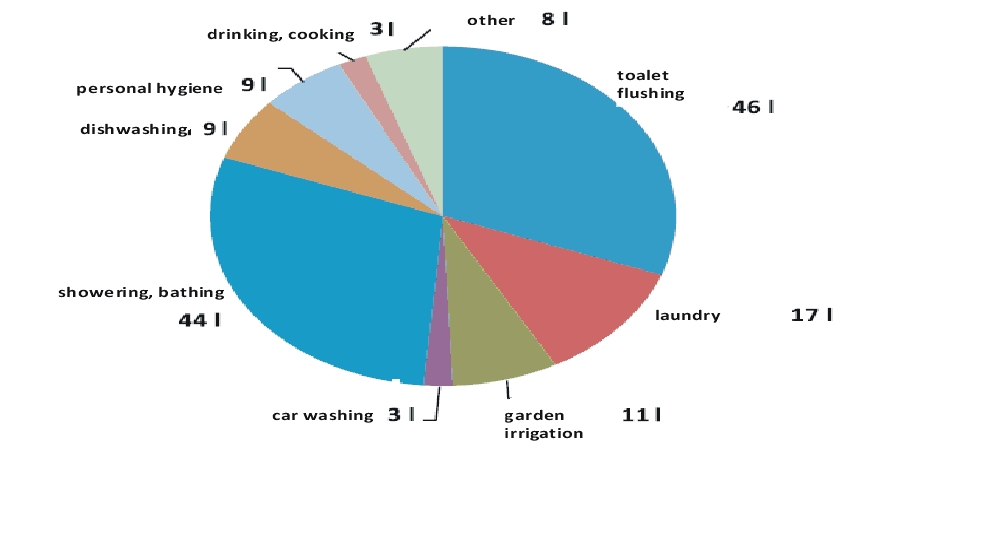
What can greywater be used for?
The greywater production fluctuates from 55 to 100 litres (l) per PE (population equivalent) per day.
By the greywater reuse, approx. 50% of the daily consumption of drinking water may be saved.
AS–GRAY WATER COMPACT UNITS - PRODUCT RANGE
In one unit, the following functions are included:
- greywater mechanical preliminary treatment,
- water accumulation,
- biological treatment and filtration,
- pumping of the water to the distribution system , and
- filling with the drinking water if the greywater production is not sufficient.
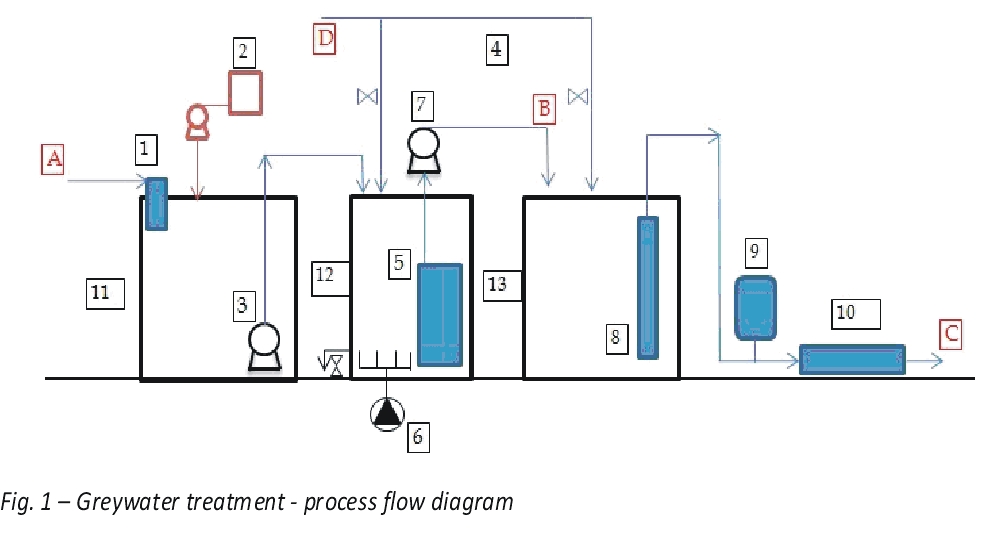
Explanation:
(1) fine-mesh screen, (2) NaOH dosing, (3) greywater re-pumping into the reactor, (4) drinking water inlet, (5) membrane module, (6) blower, (7) permeate pump, (8) ATS submersible pump, (9) membrane pressure vessel, (10) UV lamp, (11) greywater balance reservoir, (12) reaction tank, (13) clean water accumulation tank
(A) greywater, (B) permeate, (C) cleaned greywater for consumption, (D) drinking water.
Why to use grey water?
- Ever increasing price of drinking water
- Sources of good quality drinking water are limited and not always available
- Most common use for toilet flushing
- Improved building standard in LEED, BREAM, etc. systems
2 GREYWATER ENERGY CONTENT
Another aspect in the greywater use that cannot be left out of consideration, is the signifi-cant thermal potential contained there. It almost calls for the utilisation. There are two rea-sons at least: greywater contains more heat than other water types and it is relatively clean, which eliminates the biggest problem in this field – dirt deposits in heat exchangers.
Greywater temperature levels differ a great deal and depend on many aspects, such as the attendance in the relevant facilities, schedule of shifts, etc. An individual assessment of each building seems to be therefore an optimal approach. It makes sense that better economy can be expected in cases of a higher demand and greywater production as well as higher temperature levels of greywater. Greywater heat recovery is one of the possibilities of re-ducing the costs of the DHW preparation (domestic hot water) and, if applicable, building heating costs.
The energy consumption for the DHW preparation that represents a great part of generated greywater, accounts currently for approximately 25% of the total energy costs in buildings and 25 to 75% in households (in case of high-standard houses, e.g. passive houses, the DHW heat demand ratio rises with the house quality).
Methods used
The heat extraction from wastewater can be carried out either locally or centrally. The deci-sive factor influencing this selection is the wastewater flow rate. In smaller applications and family houses, local heat recovery systems flexibly reacting to the actual demand are more attractive because of their lower capital expenditures. In case of large applications, we can accumulate the wastewater, extract the heat from it and discharge it to a sewer system or a wastewater treatment plant later.
Points of wastewater heat recovery in buildings
- local applications
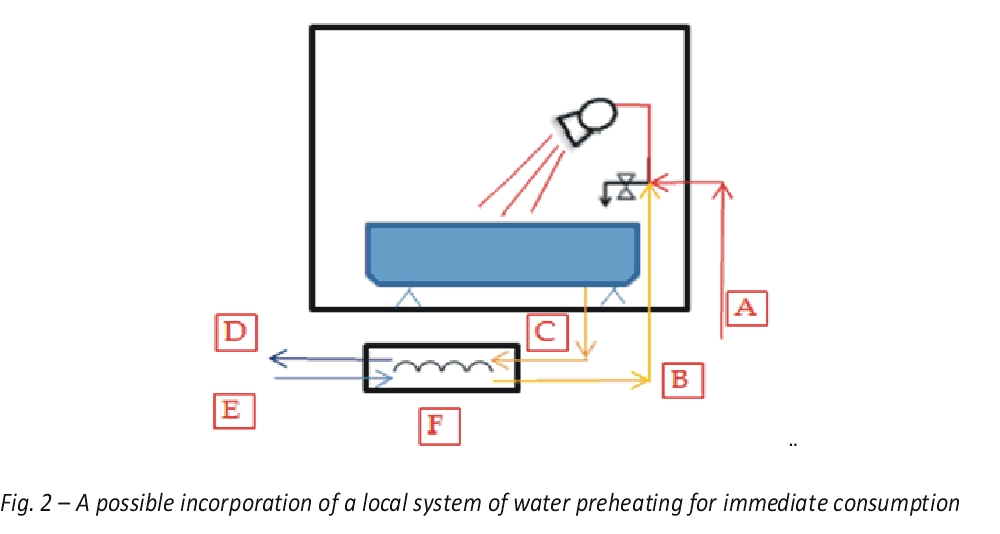
Explanation:
(A) DHW – domestic hot water, (B) pre-heated cold water, (C) hot wastewater, (D) cooled wastewater, (E) cold water, (F) heat exchanger
- centralised applications
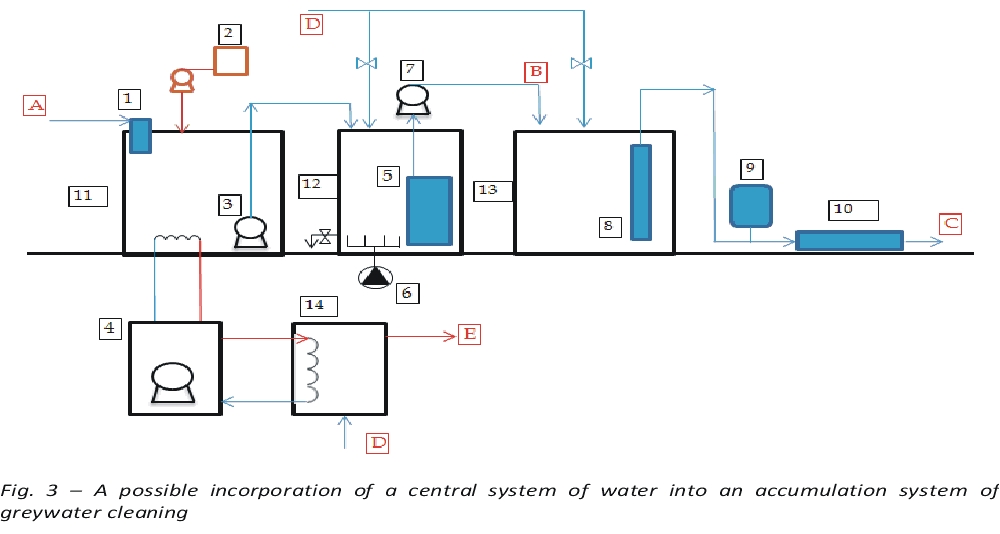
Explanation:
(1) fine-mesh screen, (2) NaOH dosing, (3) greywater re-pumping into the reactor, (4) heat pump, (5) membrane module, (6) blower, (7) permeate pump, (8) ATS submersible pump, (9) membrane pressure vessel, (10) UV lamp, (11) greywater balance reservoir, (12) reaction tank, (13) clean water accumulation tank, (14) DHW reservoir, (15) heat exchanger (A) greywater, (B) permeate, (C) cleaned greywater for consumption, (D) drinking water, (E) DHW – domestic hot water
If the heat exchanger is placed inside the greywater-balance reservoir (see Fig. 3), we can obtain the heat necessary either for direct pre-heating of DHW or – using the heat pump – we can transfer this heat to higher-temperature hot water that can either heat DHW to the necessary level (55 0C) or be used as a source in the whole heating system up to 65 0C. In terms of the heat-pump performance factor, any heating up to higher temperatures is un-economical.
From the economy point of view, it is obvious that the biggest effect can be achieved by the use of systems including also the use of rainwater and greywater as well as in the building with a large consumption of white water. Various options should take into account local conditions as well as purchased water prices.
Conclusions
One of the contemporary requirements in the new development is the so-called “sustain-ability”. This means that it is necessary to manage the water and energy sources responsibly and minimise their consumption. The utilisation of wastewater is one of these ways.
Local systems for residual heat recovery are more suitable for family houses, where water flow rate are small but so are the capital expenditures, if compared to centralised systems, which is connected with a simple design of these heat exchangers.
Central systems for residual heat recovery are capital-cost intensive, but the temperature levels obtained are far higher and thus more suitable for service applications.
In addition to wastewater treatment plants, further sources of heat include hotels, restau-rants, lodging houses, office blocks and other community facilities, but also wellness centres, swimming pools, bath houses and hospitals. In all these places, it is possible to recover a fair quantity of energy that can be re-used for own consumption reducing thus their operating costs.
Reservoir and heat exchanger designs are carried out by computer modelling with the prior aim of reducing the capital costs and increasing the system efficiency.
